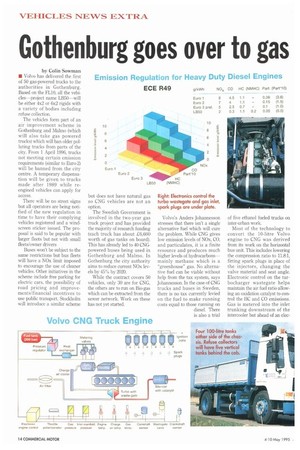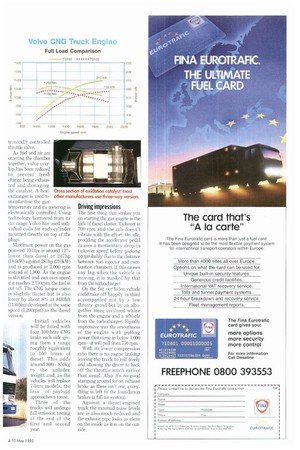Gothenburg goes over to gas
Page 16

Page 17

If you've noticed an error in this article please click here to report it so we can fix it.
by Colin Sowman • Volvo has delivered the first of 59 gas-powered trucks to the authorities in Gothenburg. Based on the FL10, all the vehi cles project name LB50—wil1 be either 4x2 or 6x2 rigids with a variety of bodies including refuse collection.
The vehicles form part of an air improvement scheme in Gothenburg and Malmo (which will also take gas powered trucks) which will ban older polluting trucks from parts of the city. From 1 April 1996, trucks not meeting certain emission requirements (similar to Euro-2) will be banned from the city centre. A temporary dispensation will be given to trucks made after 1989 while reengined vehicles can apply for access.
There will be no street signs but all operators are being notified of the new regulation in time to have their complying vehicles registered and a windscreen sticker issued. The proposal is said to be popular with larger fleets but not with small fleets/owner drivers Buses won't be subject to the same restrictions but bus fleets will have a NOx limit imposed to encourage the use of cleaner vehicles. Other initiatives in the scheme include free parking for electric cars, the possibility of road pricing and improvements/financial incentives to use public transport. Stockholm will introduce a similar scheme but does not have natural gas so CNG vehicles are not an option.
The Swedish Government is involved in the two-year gas truck project and has provided the majority of research funding (each truck has about 1:6,600 worth of gas tanks on board). This has already led to 40 CNGpowered buses being used in Gothenburg and Malmo. In Gothenburg the city authority aims to reduce current NOx levels by 45% by 2020.
While the contract covers 50 vehicles, only 30 are for CNG, the others are to run on Bin-gas which can be extracted from the sewer network. Work on these has not yet started. Volvo's Anders johannesson stresses that there isn't a single alternative fuel which will cure the problem, While CNG gives low emission levels of NOx, CO, and particulates, it is a finite resource and produces much higher levels of hydrocarbons— mainly methane which is a "greenhouse" gas. No alternative fuel can be viable without help from the tax system, says johannesson. In the case of CNG trucks and buses in Sweden, there is no tax currently levied on the fuel to make running costs equal to those running on diesel. There is also a trial of five ethanol fueled trucks on inter-urban work.
Most of the technology to convert the 10-litre Volvo engine to CNG was derived from its work on the hori2ontal bus unit. This includes lowering the compression ratio to 11.8:1, fitting spark plugs in place of the injectors, changing the valve material and seat angle, Electronic control on the turbocharger wastegate helps maintain the air fuel ratio allowing an oxidation catalyst to control the kiC and CO emissions. Gas is metered into the inlet trunking downstream of the intercooler but ahead of an elec tromcally controlled throttle valve.
As fuel and air are entering the chamber together, valve over lap has been reduced to prevent fresh charge being exhaus ted and damaging the catalyst. A heat exchanger is used to standardise the gas temperature and its metering is .electronically controlled. Using technology borrowed from its car range Volvo has used individual coils for each cylinder mounted directly on top of the plugs.
Maximum power on the gas powered 10-litre is around 12% lower than diesel at 247hp (184kW) against 281hp (210kW) and is produced at 2,000 rpm instead of 1,900. As the engine is throttled and can over-speed if it reaches 2,150rpm, the fuel is cut off. The CNG torque curve is slightly flatter but is also lower by about 8% at 8481bft (1150Nm) developed at the same speed (1,200rpm) as the diesel version.
Initial vehicles will be fitted with four 100-litre CNG tanks each side giving them a range roughly equivalent to 160 litres of diesel. This adds around 800 850kg to the unladen weight and, as the vehicles will replace 7-litre models, the loss of payload approaches a tonne.
Three of the trucks will undergo full emission testing at the end of the first and second year.
Driving impressions
The first thing that strikes you on starting the gas engine is the lack of diesel clatter. Tickover is 700 rpm and the cab doesn't vibrate with the effort. On idle, prodding the accelerator pedal causes a momentary drop in tickover speed before picking up (probably due to the distance between fuel injector and combustion chamber). If this causes any lag when the vehicle is moving, it is masked by that from the turbocharger.
On the flat our laden vehicle could take off happily in third accompanied not by a low throaty growl but by an altogether more civilised whine from the engine and a whistle from the turbocharger. Equally impressive was the smoothness of the engine with pulling power that came in below 1.000 rpm it will pull from 750 rpm.
With its lower compression ratio there is no engine braking leaving the truck to roll freely and allowing the driver to back off the throttle much earlier than usual. Also it's no good stamping around for an exhaust brake as there isn't one, everything is left to the foundation brakes (a full air system).
Against a diesel-engined truck the external noise levels are is also much reduced and the exhaust pipe looks as clean on the inside as it is on the outside.
















































































































